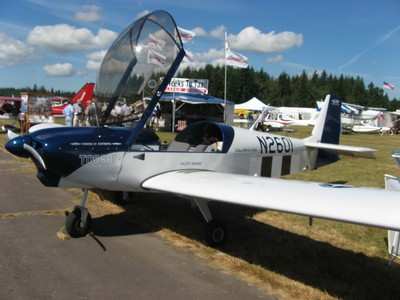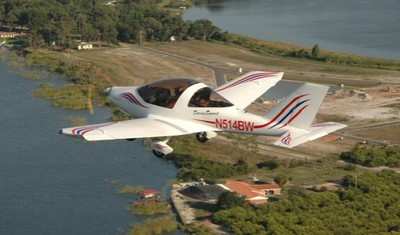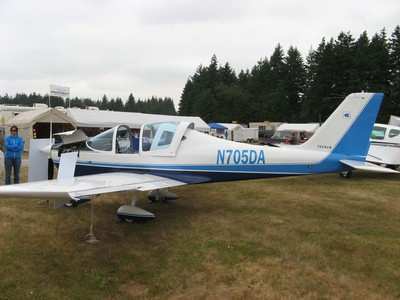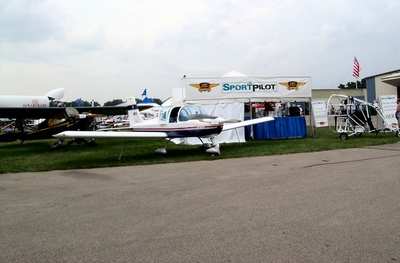Two Years In, Many Successes... And Challenges
It isn't hard to see at this year's Northwest EAA Fly-In that
the two-year-old sport pilot category has become a big deal. From
the airplanes gathered on the field, to the many forums devoted
solely to category-specific issues, the emerging sport pilot
category -- and the airplanes that go along with it -- are destined
to be a big part of the general aviation picture in the future...
if the EAA has anything to say about it.

Ron Wagner, Manager of Field Relations for the EAA and the
self-designated "face" of sport pilot, told ANN that over the two
years since sport pilot was introduced, the category has seen
extensive growth -- particularly in the number of light-sport
aircraft on the market. He also spoke of some of the challenges the
program still faces -- and how those issues can be resolved.
The Aircraft
"It's exciting to think about 36 new designs in the last 14-15
months, as opposed to four or five new designs over the past 50
years," said Wagner, talking about the surge in availability of a
wide selection of LSAs to choose from.

While light-sport planes are significantly cheaper than their
Part 23 brethren, the price tags on most of them -- topping
$100,000 for many well-equipped examples -- have received criticism
from customers... but Wagner says customers may soon see a price
break.
"We're right on the verge of a lot of American companies finally
getting involved," said Wagner. "It's important to realize that
$10,000 to $20,000 of the price tags on current [European] light
sport aircraft are eaten up by exchange rates... so once the
American designs come online, those prices will come down."

"We have to get the flight schools around the country educated
as to the opportunity that this presents to them," said Wagner.
"Right now, they don't have the aircraft in their inventory... so
the natural response is to say "we don't have a [light sport]
aircraft available... so why don't you become a private pilot
instead?"
"It's important that we get the flight schools educated to the
light sport aircraft... and how these can be used in many more
roles than just training people to become a sport pilot. It's going
to add to their rental fleet... and these same aircraft can be used
as basic trainers no matter what rating [students] are working
on."
The Pilots
The intended reach of the sport pilot category is, of course,
twofold. It is aimed at drawing new pilots into the fold, and do so
for less cost than in the past... and, sport pilot is also meant to
give older pilots a way to stay in the skies, even if they feel
that, while they're still healthy enough to fly, renewing or
obtaining their medical.

Wagner says reactions from both sides have been encouraging...
but older pilots have dominated the category to date.
"Obviously when the rule was first enacted, the only ones who
could be sport pilots were those who simply let their medical
expire, and exercise sport pilot privileges," said Wagner. "We knew
they'd be the first wave."

"Right now, though, we're seeing a lot of the ultralighters
transitioning, and in areas where there is a training aircraft
available, we're seeing a lot of new people become involved," said
Wagner. "There's the beginnings of a shift... how fast it happens
depends on how fast the industry responds, and the flight schools
respond."
The Obstacles
When asked if there was one restriction to sport pilot that he
would like to see wiped away, Wagner was quick to
reply.

"The more I've gotten into this, it's a very, very well written
rule," he said. "There are some glitches, such as repositionable
gear [which primarily applies to amphibious planes; the current
rule -- as written "by a clerk," Ron says -- stipulates that
landing gear cannot be repositioned in flight -- so if you took off
from the water, you must land on the water, too -- Ed.]. I'll
certainly be glad when that works out."
"I'll be glad when the ultralight transition period is
completed, frankly," Wagner added. "That will allow the industry to
focus on getting new people involved. The ultralight transition
program is coming along quite well, but there's a lot of confusion
in the community as they get into this."
In the end, Wagner says, pilots must be careful to respect the
category -- and not use it as a means to fly when, truthfully, they
probably shouldn't be. In a forum given at Arlington, Ron related
the story of an 87-year old man who had difficulty walking, who had
thanked Ron and the EAA for giving him a way to take his grandson
flying.
"I told him that it would probably be better if he used his
money to pay for his grandson's flying lessons instead," Wagner
told the packed forum. "That way, he could still go flying with his
grandson, but not as pilot-in-command. You don't ALWAYS have to be
PIC."

"We are all responsible for the future of sport pilot," Wagner
said to the pilots gathered. "It is, ultimately, ours to lose."
 Senator Pushes FAA to Accelerate Rocket Launch Licensing
Senator Pushes FAA to Accelerate Rocket Launch Licensing Classic Aero-TV: RJ Gritter - Part of Aviations Bright New Future
Classic Aero-TV: RJ Gritter - Part of Aviations Bright New Future Aero-FAQ: Dave Juwel's Aviation Marketing Stories -- ITBOA BNITBOB
Aero-FAQ: Dave Juwel's Aviation Marketing Stories -- ITBOA BNITBOB ANN's Daily Aero-Linx (10.27.24)
ANN's Daily Aero-Linx (10.27.24) ANN's Daily Aero-Term (10.27.24): Clearance Void If Not Off By (Time)
ANN's Daily Aero-Term (10.27.24): Clearance Void If Not Off By (Time)








